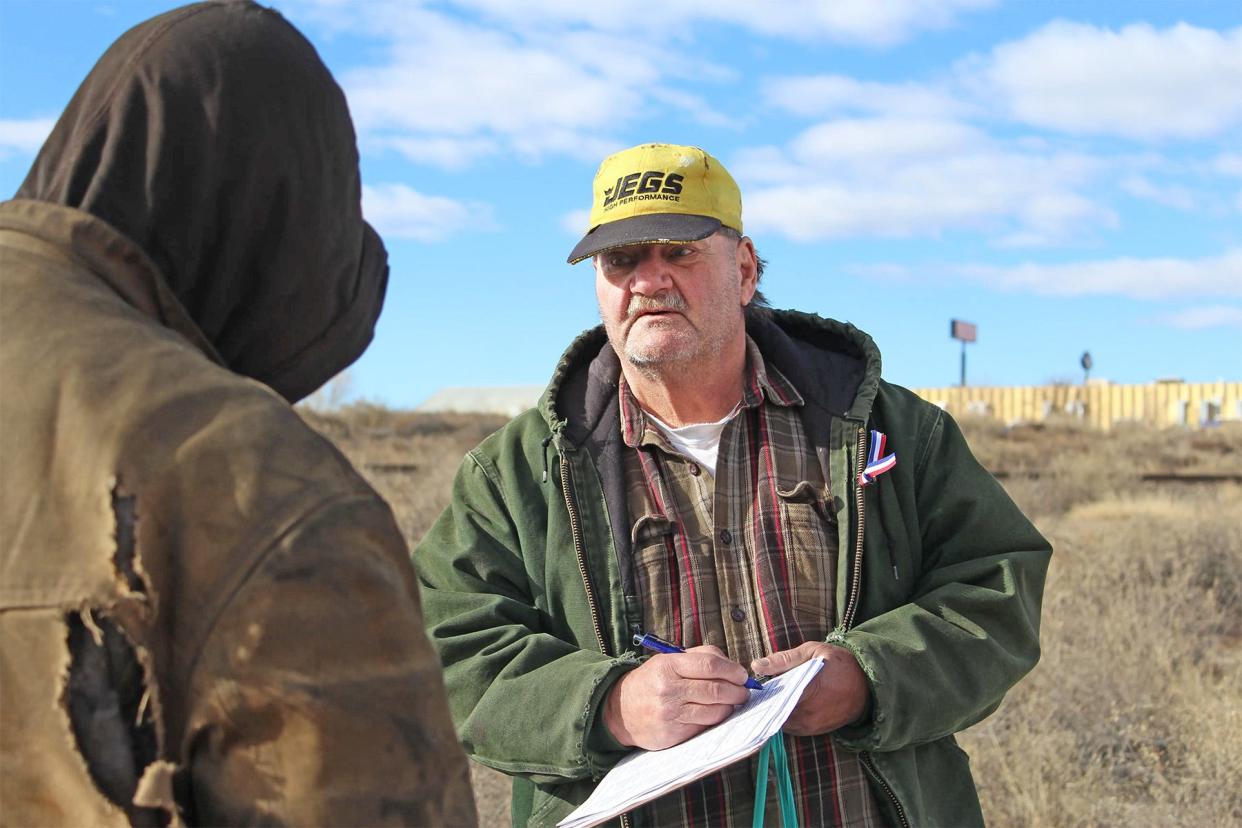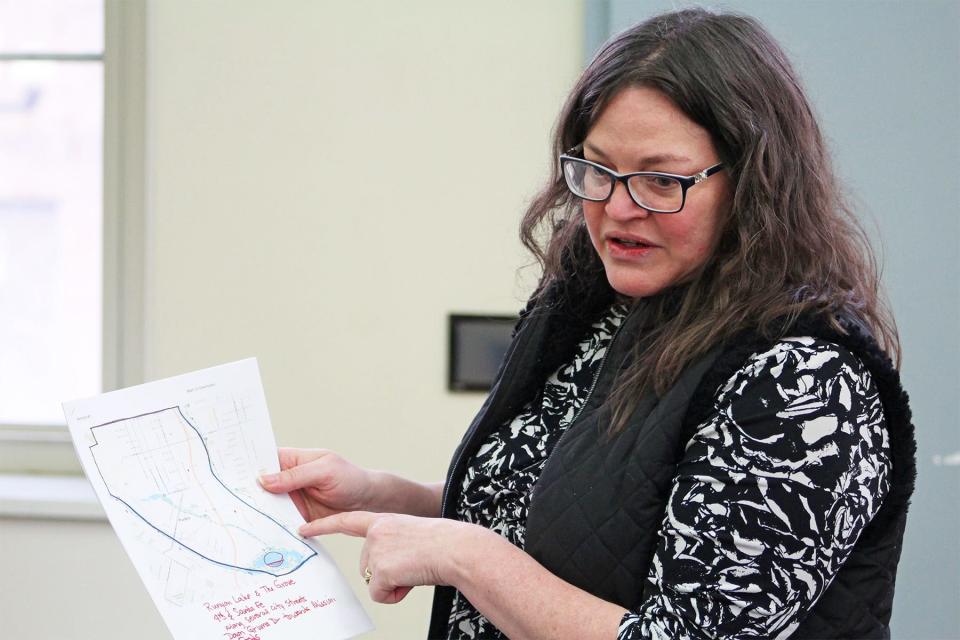Point-in-time count sheds light on barriers, hardships facing Pueblo's unhoused

Around noon on a sunny but frigid Saturday near Belmont in Pueblo, Gene Bonney heard the voice of volunteer Jimmy Duffner asking if anyone in the area would like some food and water. Bonney was chatting with a friend, who told Duffner it was OK to walk over after he spotted them.
Bonney had yet to speak with Duffner, who held a clipboard with a sheet of paper on it. On that paper was a survey with a series of detailed questions designed to help local organizations and the state gauge the extent of homelessness in Pueblo and uncover unidentified needs of the local unhoused population.
Bonney, in need of assistance, lent a hand to his friend, who helped him slowly emerge from his home — a small makeshift underground shelter with slabs of scrap wood toppled on one another to mimic a roof.
receptive to Duffner’s request, Bonney started to answer some of his questions, joining hundreds of others experiencing homelessness in participating in Pueblo’s point-in-time count.
Duffner, a volunteer and member of multiple community coalitions to address homelessness, viewed that interaction as a win in itself.
“This is the most important week of the year for the unhoused,” Duffner said. “If you want to get resources down here, you have to have a good count.”
Bonney, 51, is from Wyoming but has spent at least the past three years in Pueblo and more than a year experiencing homelessness.
He once made up to $6,000 each month, he said, but suffered a severe head injury while working a job pouring concrete in Beulah. It wasn’t long after that his income dropped to about $800 per month and he found himself unable to make ends meet. The bills piled up.
“I lost everything,” Bonney said. “Two houses, two cars, the world.”
On top of the brain injury he experienced, Bonney also has severe sciatic nerve damage that makes it hard for him to stand.
He said “yes” when asked by Duffner if he has a serious mental illness, a question asked to all people who take part in the survey so Pueblo County can send more detailed information to the U.S. Department of Housing and Urban Development, which helps determine how much the agency should send, based on the information it receives, to organizations that later seek financial assistance to help them address the homelessness crisis.
The count is conducted through the Colorado Balance of State Continuum of Care and Pueblo is one of 10 regional coalitions across the state.
“About half the people have no interest in doing the survey,” Duffner said. “When they do the survey, it’s a really big deal.”
Duffner was one of about 30 Pueblo volunteers who helped tabulate and survey hundreds of people experiencing homelessness across four days. He said it was often difficult to locate unhoused people in areas he covered, mostly because they scattered to different places after being “threatened with legal repercussions” by law enforcement.
Those kinds of threats can make people experiencing homelessness suspicious of anyone who comes near their camp or site, even those who are trying to help, Duffner said. Some of the unhoused individuals sleep under bushes and bridges, while some camps aren’t easy to access.
“The first thing (Pueblo) needs to do (to address homelessness) is set up safe parking and camping sites around town because locating these people and getting them services is next to impossible,” Duffner said.
Organizers say actual count is 'definitely more than 200'

Teah Miller, the Colorado Balance of State Continuum of Care community facilitator for Pueblo County, and her group of volunteers counted at least 200 unsheltered people experiencing homelessness over the four-day count. HUD considers people who sleep in a place that’s not designed or used as a regular sleeping accommodation as “unsheltered” homeless.
The team had a count of at least 100 sheltered people, Miller said, though that number is likely higher.
Miller won’t see an official number of how many people were counted — the unsheltered and sheltered counts are combined — or findings from the demographic and health information collected from each person surveyed until the state releases that data in late February or early March.
Miller said she doesn’t know how much more it is, but knows there were “definitely more than 200” unsheltered homeless counted. It’s difficult to know or have an exact estimate at this time, she said, because this was the first year where the team could use electronic surveys, which could be submitted and packaged with the rest of the information that’s sent to the state.
But no matter the final number, it’s likely an undercount, Miller said. Duffner suspects Pueblo’s homeless population could total more than 1,000.
“We know that the point-in-time count is an undercount and underrepresentation (of the unhoused population),” Miller said.
Those experiencing homelessness say it's 'just dreadful'
Kathy Cline, a volunteer and former executive director of the Pueblo Rescue Mission, said she saw just one orange syringe cap after traveling around nearly all of Pueblo during the time she participated in the count.
“That’s pretty critical for people to know,” said Cline, who disputed harmful rumors that all unhoused people are addicts or use drugs.
“As an (empathetic) human I know people that are drug addicts are human beings, but I’m clean,” said a man experiencing homelessness who goes by the nickname Junior. “I want out. I want help.”
Junior and his father, whose nickname is Senior, have been homeless in Pueblo for almost two years and live in a tent.
During the count, Duffner encountered Junior, who said he was once a varsity football captain at his high school in California. Junior hasn’t been able to find work in Pueblo despite applying to several open positions, he said. He recently worked the graveyard shift at a local gas station but was let go.
“I’m just asking to get my life back,” Junior said. “I had a good life, but then everything went downhill. (Homelessness) is just dreadful, man.”
Senior said employers aren’t likely to hire him because he has a herniated disk and must see five to six doctors a week after being diagnosed with Stage 2 cancer. He’s encountered barriers trying to obtain his disability checks and said he and Junior often walk miles to ask for help and five miles each way when they need to do laundry.
“We struggle every day,” Senior said. “Do you know what a struggle it is to take a shower to feel clean?”
Senior said he wishes people could ask him if he needs help, bring him a blanket or say a prayer for him and his son rather than treat and look at him like “he’s dirtying up the place” and is “no good.”
“The barriers and things that the homeless have to overcome is almost insurmountable,” Duffner said. “God help you if you slip into alcoholism or any kind of drug addiction. That’s just another mountain to climb.”
Taking a more graceful approach
Cline participated each day of the count, which is done every odd year, and said she encountered unhoused people she's helped before and didn’t see a large number of new individuals from other cities or states, which she said is a common misconception she hears in the community.
She said she was surprised to see people among the unhoused population take more “refusal stances” with volunteers and act with heightened concern, likely to avoid “getting targeted” or “mowed down,” she said.
That feeling among the homeless population has vacillated over the past 15 years, she said, but was more noticeable during this year’s count because being targeted or forced to move their camp “is still a fear.”
“I believe you have to lead with grace,” Cline said. “That’s how we help these folks. You lead with grace, and you can get really far.”
Bonney said he wishes “someone would give him a chance” to obtain housing. He also believes at least half of the homeless population in Pueblo would pounce on the opportunity if they were offered shelter in abandoned buildings converted into shelters or housing complexes and given a 60-day requirement to find work so they can pay for rent.
“Sure, there’s a few bad seeds, but there’s a few bad seeds in everything,” Bonney said. “You can’t hold everyone (among the unhoused population) responsible for that.”
Bonney also said he believes more action would be taken to address homelessness if the roles among populations were reversed.
“Give people (who make financial decisions in Pueblo) one weekend out here with no wallet and tell them, ‘Go survive,’” Bonney said. “See how many buildings they open up after that. I bet you half of them.”
Federal funds that may be issued to community organizations because of the point-in-time count can be used to build programming that addresses specific needs that are shared by the unhoused population, Miller said.
“It’s not a simple solution,” Miller said when asked what more could be done to address homelessness. “Gathering all the data (from the count) and putting it all together will help guide those decisions.”
Chieftain reporter Josue Perez can be reached at JHPerez@gannett.com. Follow him on Twitter @josuepwrites.
This article originally appeared on The Pueblo Chieftain: Pueblo point-in-time count highlights needs of local unhoused population

